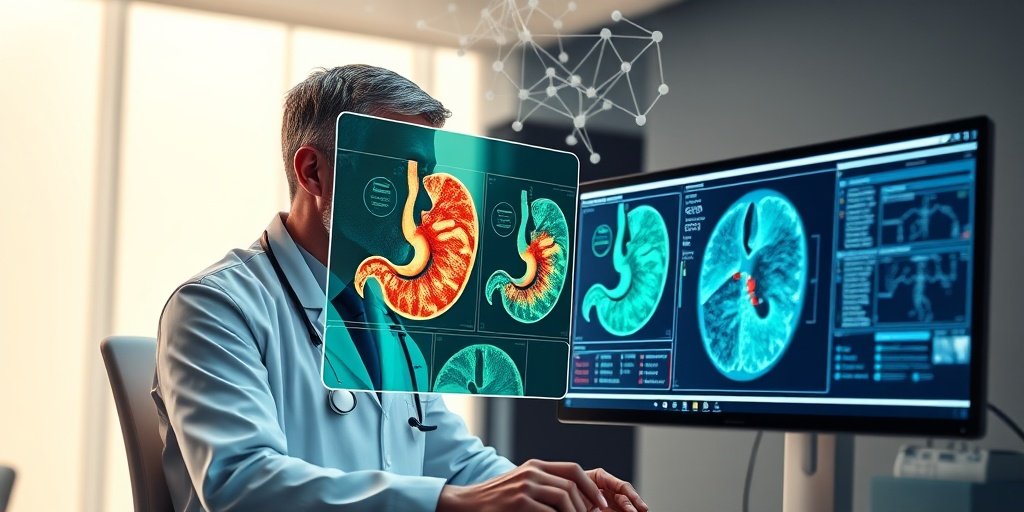⚡ Quick Summary
This study introduces a novel deep learning fusion approach for detecting gastric cancer by combining three AI architectures, achieving an impressive accuracy of 97.8%. The integration of Explainable Artificial Intelligence (XAI) techniques enhances the model’s transparency, making it a valuable tool for clinical applications.
🔍 Key Details
- 📊 Methodology: Fusion of VGG16, RESNET50, and MobileNetV2 architectures
- 🧩 Features used: Image data for gastric cancer detection
- ⚙️ Technology: Deep learning with Explainable AI (LIME)
- 🏆 Performance: Fusion model accuracy of 97.8%, 7% improvement over individual models
🔑 Key Takeaways
- 📊 Enhanced detection: The fusion model significantly improves accuracy in gastric cancer detection.
- 💡 Explainability: LIME provides insights into the model’s decision-making process, enhancing trust.
- 👩⚕️ Clinical relevance: The model’s transparency makes it suitable for medical practitioners.
- 🏥 Potential applications: This AI-driven system can support clinical decisions and improve patient outcomes.
- 🌍 Research contribution: This study advances the development of trustworthy AI systems in healthcare.

📚 Background
The increasing incidence of gastric cancer necessitates the development of accurate and timely detection methods. Traditional detection techniques often struggle with issues of explainability and precision, highlighting the need for an interpretable AI-based system that can enhance patient well-being through improved diagnostic capabilities.
🗒️ Study
This research proposes a deep learning fusion approach that combines three established architectures—VGG16, RESNET50, and MobileNetV2—to enhance the detection of gastric cancer. By leveraging robust feature extraction and global contextual understanding, the study aims to improve the accuracy of cancer detection systems. The integration of the Local Interpretable Model-Agnostic Explanations (LIME) technique further aids in providing transparency into the model’s decision-making process.
📈 Results
The experimental results indicate a remarkable 7% increase in accuracy for the fusion model, achieving an overall accuracy of 97.8% compared to the individual models. The application of LIME effectively highlights critical regions in the images that contribute to cancer detection, enhancing the interpretability of the model’s predictions.
🌍 Impact and Implications
The enhanced accuracy of gastric cancer detection through this study offers significant implications for clinical applications. The use of LIME ensures that predictions made by the model are trustworthy and reliable, which is crucial for medical practitioners. This research contributes to the development of an AI-driven, trustworthy cancer detection system that can support clinical decisions and ultimately improve patient outcomes.
🔮 Conclusion
This study highlights the potential of interpretable deep learning in the realm of gastric cancer detection. By combining advanced AI architectures with explainability techniques, healthcare professionals can achieve more accurate and reliable diagnostic outcomes. The future of AI in healthcare looks promising, and further research in this area is encouraged to enhance patient care and treatment strategies.
💬 Your comments
What are your thoughts on the integration of AI in cancer detection? We would love to hear your insights! 💬 Leave your comments below or connect with us on social media:
Interpretable deep learning for gastric cancer detection: a fusion of AI architectures and explainability analysis.
Abstract
INTRODUCTION: The rise in cases of Gastric Cancer has increased in recent times and demands accurate and timely detection to improve patients’ well-being. The traditional cancer detection techniques face issues of explainability and precision posing requirement of interpretable AI based Gastric Cancer detection system.
METHOD: This work proposes a novel deep-learning (DL) fusion approach to detect gastric cancer by combining three DL architectures, namely Visual Geometry Group (VGG16), Residual Networks-50 (RESNET50), and MobileNetV2. The fusion of DL models leverages robust feature extraction and global contextual understanding that is best suited for image data to improve the accuracy of cancer detection systems. The proposed approach then employs the Explainable Artificial Intelligence (XAI) technique, namely Local Interpretable Model-Agnostic Explanations (LIME), to present insights and transparency through visualizations into the model’s decision-making process. The visualizations by LIME help understand the specific image section that contributes to the model’s decision, which may help in clinical applications.
RESULTS: Experimental results show an enhancement in accuracy by 7\% of the fusion model, achieving an accuracy of 97.8\% compared to the individual stand-alone models. The usage of LIME presents the critical regions in the Image leading to cancer detection.
DISCUSSION: The enhanced accuracy of Gastric Cancer detection offers high suitability in clinical applications The usage of LIME ensures trustworthiness and reliability in predictions made by the model by presenting the explanations of the decisions, making it useful for medical practitioners. This research contributes to developing an AI-driven, trustworthy cancer detection system that supports clinical decisions and improves patient outcomes.
Author: [‘Ma J’, ‘Yang F’, ‘Yang R’, ‘Li Y’, ‘Chen Y’]
Journal: Front Immunol
Citation: Ma J, et al. Interpretable deep learning for gastric cancer detection: a fusion of AI architectures and explainability analysis. Interpretable deep learning for gastric cancer detection: a fusion of AI architectures and explainability analysis. 2025; 16:1596085. doi: 10.3389/fimmu.2025.1596085